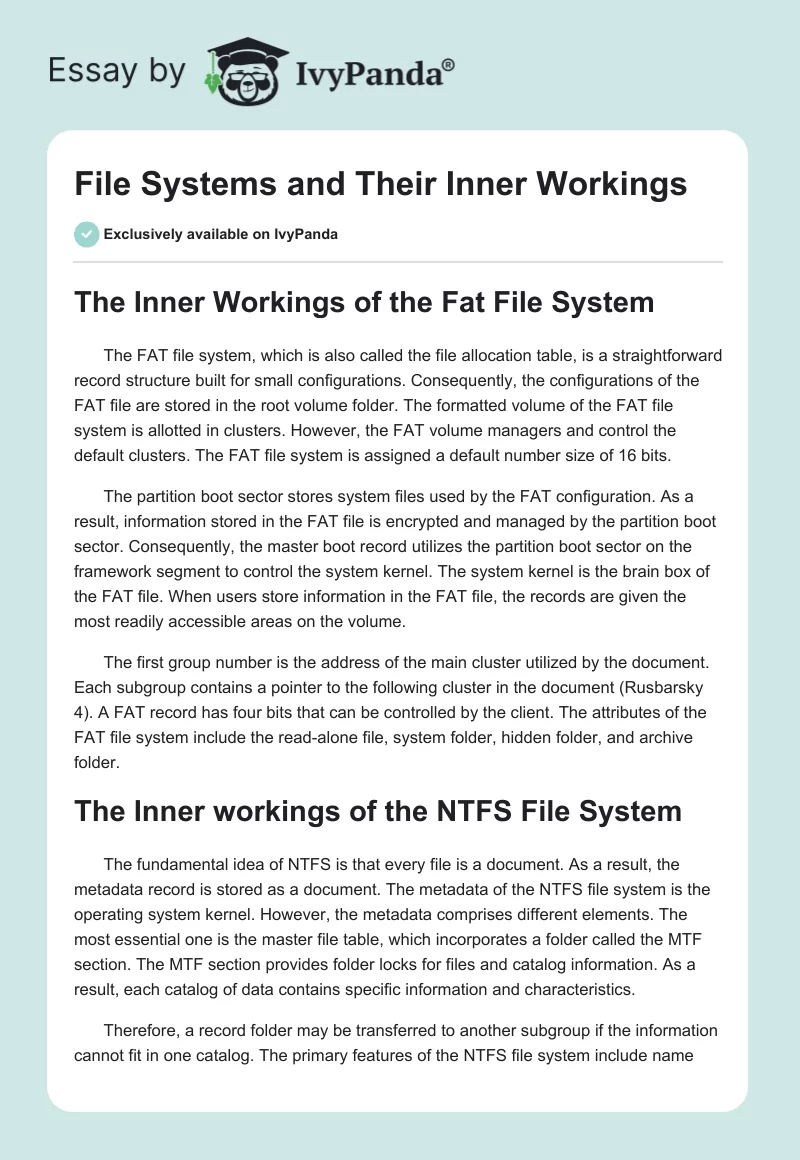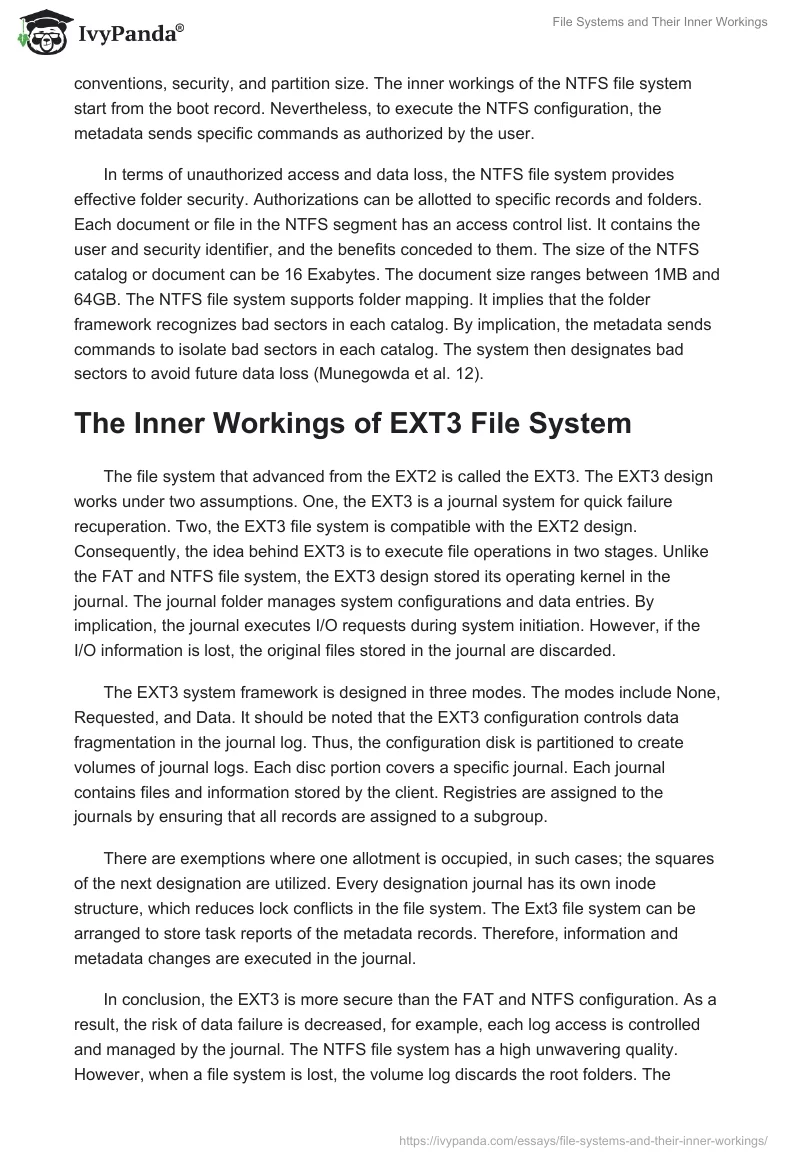The Inner Workings of the Fat File System
The FAT file system, which is also called the file allocation table, is a straightforward record structure built for small configurations. Consequently, the configurations of the FAT file are stored in the root volume folder. The formatted volume of the FAT file system is allotted in clusters. However, the FAT volume managers and control the default clusters. The FAT file system is assigned a default number size of 16 bits.
The partition boot sector stores system files used by the FAT configuration. As a result, information stored in the FAT file is encrypted and managed by the partition boot sector. Consequently, the master boot record utilizes the partition boot sector on the framework segment to control the system kernel. The system kernel is the brain box of the FAT file. When users store information in the FAT file, the records are given the most readily accessible areas on the volume.
The first group number is the address of the main cluster utilized by the document. Each subgroup contains a pointer to the following cluster in the document (Rusbarsky 4). A FAT record has four bits that can be controlled by the client. The attributes of the FAT file system include the read-alone file, system folder, hidden folder, and archive folder.
The Inner workings of the NTFS File System
The fundamental idea of NTFS is that every file is a document. As a result, the metadata record is stored as a document. The metadata of the NTFS file system is the operating system kernel. However, the metadata comprises different elements. The most essential one is the master file table, which incorporates a folder called the MTF section. The MTF section provides folder locks for files and catalog information. As a result, each catalog of data contains specific information and characteristics.
Therefore, a record folder may be transferred to another subgroup if the information cannot fit in one catalog. The primary features of the NTFS file system include name conventions, security, and partition size. The inner workings of the NTFS file system start from the boot record. Nevertheless, to execute the NTFS configuration, the metadata sends specific commands as authorized by the user.
In terms of unauthorized access and data loss, the NTFS file system provides effective folder security. Authorizations can be allotted to specific records and folders. Each document or file in the NTFS segment has an access control list. It contains the user and security identifier, and the benefits conceded to them. The size of the NTFS catalog or document can be 16 Exabytes. The document size ranges between 1MB and 64GB. The NTFS file system supports folder mapping. It implies that the folder framework recognizes bad sectors in each catalog. By implication, the metadata sends commands to isolate bad sectors in each catalog. The system then designates bad sectors to avoid future data loss (Munegowda et al. 12).
The Inner Workings of EXT3 File System
The file system that advanced from the EXT2 is called the EXT3. The EXT3 design works under two assumptions. One, the EXT3 is a journal system for quick failure recuperation. Two, the EXT3 file system is compatible with the EXT2 design. Consequently, the idea behind EXT3 is to execute file operations in two stages. Unlike the FAT and NTFS file system, the EXT3 design stored its operating kernel in the journal. The journal folder manages system configurations and data entries. By implication, the journal executes I/O requests during system initiation. However, if the I/O information is lost, the original files stored in the journal are discarded.
The EXT3 system framework is designed in three modes. The modes include None, Requested, and Data. It should be noted that the EXT3 configuration controls data fragmentation in the journal log. Thus, the configuration disk is partitioned to create volumes of journal logs. Each disc portion covers a specific journal. Each journal contains files and information stored by the client. Registries are assigned to the journals by ensuring that all records are assigned to a subgroup.
There are exemptions where one allotment is occupied, in such cases; the squares of the next designation are utilized. Every designation journal has its own inode structure, which reduces lock conflicts in the file system. The Ext3 file system can be arranged to store task reports of the metadata records. Therefore, information and metadata changes are executed in the journal.
In conclusion, the EXT3 is more secure than the FAT and NTFS configuration. As a result, the risk of data failure is decreased, for example, each log access is controlled and managed by the journal. The NTFS file system has a high unwavering quality. However, when a file system is lost, the volume log discards the root folders. The framework likewise has an extraordinary measure of adaptation to internal failure. If data is lost, the logged configuration is utilized to recoup the information. In comparison, the NTFS, FAT, and EXT3 file system are differentiated by size, log entries, and metadata.
Works Cited
Munegowda, Keshava, et al. “Evaluation of File Systems for Solid State Drives.” Emerging Research in Computing, Information, Communication and Applications, 2014. Web.
Rusbarsky, Kelsey. “A Forensic Comparison of NTFS and FAT32 File Systems.” Forensic Science, 2012. Web.


